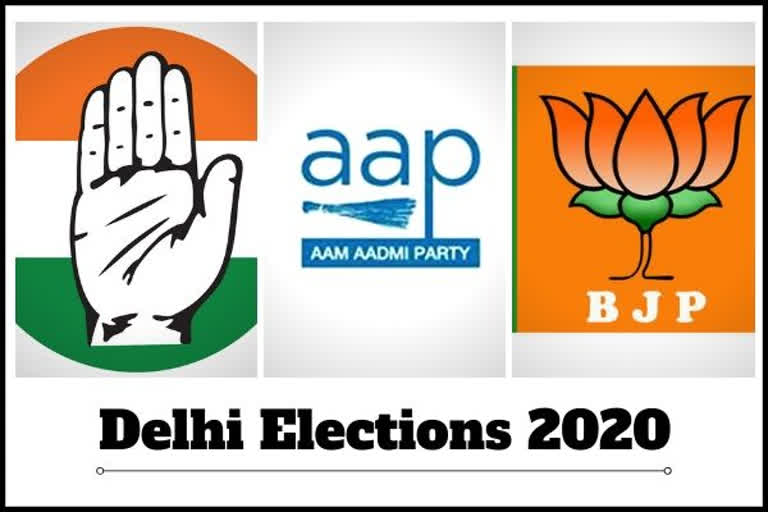New Delhi: Not only as the capital of the world's largest democracy, Delhi is unique as the metropolis' population of two crores is bigger than the populations of 140 countries.
When the Election Commission declared the election schedule to the 70-member Delhi Assembly for 8 February, the political scenario in the capital of the country turned interesting. The EC has set up 13,750 polling stations and appointed 90,000 polling executives for the polling exercise covering more than one crore forty-seven lakh voters.
For the first time, senior citizens over 80 years and physically disabled voters will have the privilege of voting through postal ballot. Enrollment of voters till the nomination process is over and QR code on voter slips is the special feature of the election this time.
Of the six elections held to the Assembly of the National Capital city, BJP won the first time. After a three-term rule by the BJP, Congress won three times under the leadership of Sheila Dixit. With the entry of the Aam Aadmi Party (AAP) in November 2012 under the leadership of Kejriwal, the domination of the two national parties ended. With its consecutive victories in 2013 and 2015, AAP has emerged as the favourite of Delhi's voters.
During the 2015 elections, AAP bagged 67 seats with 54.3 per cent vote share. However, its dismal performance with 26 per cent votes in 2017 Municipal elections and 18 per cent vote share in last year's Lok Sabha elections, is raising new hopes among its rivals.
In the 2014 Lok Sabha polls, Modi mania swept all seven Lok Sabha seats in Delhi but the low score of three seats in the 2015 Assembly elections, is disheartening to the BJP. Though the BJP recorded an unprecedented success in last year’s Lok Sabha elections, it is wary of the voters’ mood for the Assembly elections. Congress is worried about being left out in the election fray.
Kejriwal established AAP with the slogan: "We are first-rate citizens, but are sufferers in the hands of a third rate government." He also selected broom as his election symbol to convey the idea of sweeping away corruption in government machinery and swept the polls in 2013.
It shocked Congress by bagging 28 seats with 29.5 per cent of the vote share and came to power with the outside support of Congress. Kejriwal quit after disagreeing with the Center in the wake of the Jan Lokpal Bill within seven weeks. People voted AAP to power in 2015 with a thumping majority.
Kejriwal's futile effort to extend his party's footprint at a national level is well known. Except in Punjab, his vote share was even less than NOTA in other states, which is indicative of the limited presence of AAP nationally.
During the first week of July last year, Supreme Court gave a landmark judgment supporting the case of AAP and advising the Lt. Governor of Delhi to follow the advice of the Council of Ministers in all other matters except police and law and order and gave clarity on the demarcation of powers. While the BJP is accusing that there has been no progress in the regime of AAP, Congress has been protesting that the progress achieved during the regime of Sheila Dikshit has not been sustained. AAP, however, is confidently marching with its slogan: "acche bitay paanch saal -- lage raho Kejriwal" (Five-year rule of Kejriwal has been very good -- stick to him).
During the last Assembly elections, BJP's declaration of the well known IPS officer, Kiran Bedi as Chief Ministerial candidate did not attract the public. However, it is hopeful of its chances for victory, if it can muster the support of 7% more voters to the already existing 34% vote share.
AAP is trying to cash on the situation that BJP and Congress are unable to show a suitable alternative to Kejriwal as CM, and confident of winning the polls by projecting the progress it achieved in the past five years. During 2015 Assembly elections, Congress could not open its account with 9.7 per cent vote share. However, it is hopeful of its winning chances given the fact that during the last year's Lok Sabha elections, it secured second place in five out of seven constituencies.
Kejriwal government's initiative in key areas such as education, health, electricity, drinking water, transport, and women's security has become popular in an environment where the major conflict seems to be between the AAP and the BJP, which is in power both at the centre and Delhi.
While BJP claims the credit of awarding 'pattas' to the 1731 unauthorized colonies of Delhi, AAP is claiming the credit for providing the required infrastructure there. While surveys like the IANS-C voter predict victory to AAP, the real competition is going to be between the crowd-pulling capacity of Modi and pro-incumbency for Kejriwal. At a time of dwindling popularity in different states, it is to be seen what strategies the BJP is going to adopt to secure power in Delhi.
ALSO READ: AAP govt constructed 20k new classrooms in 5 years, says Arvind Kejriwal



